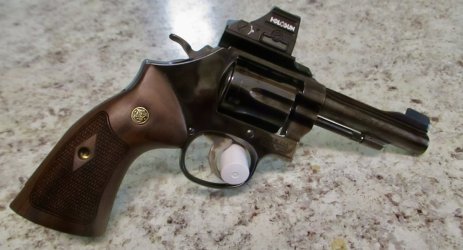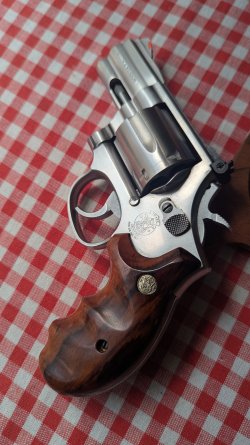I carried SW wheel guns in federal and local law enforcement and collect them for over 50 years. I first became a CCW instructor n 1996, I am not new to this.
I have a pile of wheel guns of various brands, most at SW. That said, do the following:
(1) decide what is your most likely need or use for the gun, target, carry, home defense, etc. If defense is on the list, forget about the 22 in a wheel gun. You already have one for general shooting.
(2) decide how and when you will carry this gun. If for defensive carry, barrel should be 4 inches or less, 2 inches is perfect, if you learn to shoot the gun with a short barrel.
(3) decide caliber. I have 44 mags in 2.75 inch, 4 and 5.5. They are great defense guns, but too heavy and more power than needed. If you need 357 power, then get one, if not them the 38 special can be had in small light packages. Ignore the 9mm as a first wheel gun. I love moon clips, but they are required or many guns will not fire without them. Just buy the 38 or maybe 38 H and R magnum as you enjoy. The 38 is always cheaper and ammo is everywhere, and even target wadcutters will work for defense, we know that because of the success of the NY stake out squads, the won more close gun fights than any other round. But premium defense ammo for carry and forget about it.
(4) The feel in your hand is never the reason to buy a handgun, it is the feel of the gun in the hand when you fire it and hit your point of aim, they are not the same. Only an idiot buys a "defense gun" because it feels good or looks good or because somebody else said you should, buy what works for you, not them.
(5) Never buy a handgun because somebody else told you that shooting Plus P or magnum ammo would wear them out. Who cares? You are only going to use the top power loads when you need them, not 10,000 rounds per year. And and 10,000 rounds at 50 cents each, how many are you really going to fire each year? That is $5,000 for each such gun, ignore those guys who talk about guns wearing out. And.....buy a gun with a warranty, and forget about it.
(6) The 22s in the J Frame are all hard to pull the trigger DA, it is a design issue, forget about them for carry for lack or power and worthless DA trigger pull, you cannot fix them with lower power springs, they become unreliable.
So this is a first gun. I am a SW nut, I have lots and most will cost $750 up these days. You can find a comparable Taurus for half that, I have some, they are equal in quality to most of my Smith and Wessons, just the way it is and they have a lifetime warranty, you have no risk except for long repair times, just an option.
If you do not mind heavy, buy the 3 or 4 inch K frame in 357.. If you want lighter, get a 6 shot 38, they fit in a pocket. Taurus, Colt, Kimber and Ruger make them and others. As long as they have a warranty you have no risk.
Adjustable sights. I shoot snub nose guns at rainbows, most do not, I can hit gallon jugs at 100 yards, you can too if you try. That said, you must have adjustable sights if you want to shoot point of aim at distance. If it is only defensive carry it does not matter. I do not want anymore fixed sight guns, just me.
So, go buy that 38 or 357 of some time and give us some range reports.


